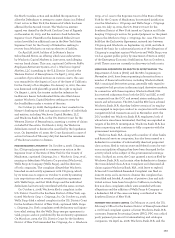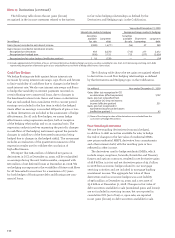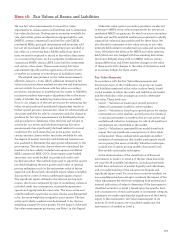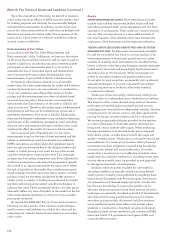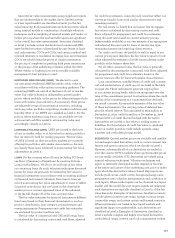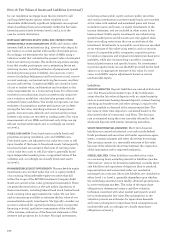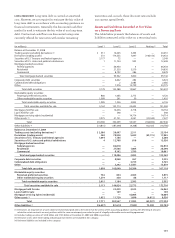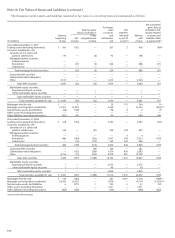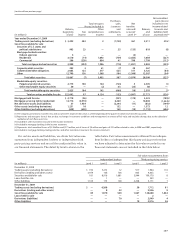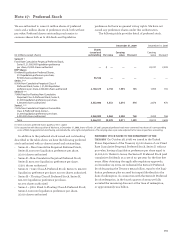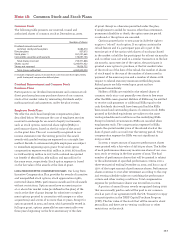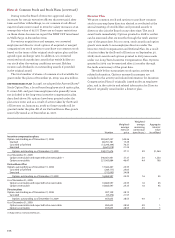Wells Fargo 2009 Annual Report Download - page 156
Download and view the complete annual report
Please find page 156 of the 2009 Wells Fargo annual report below. You can navigate through the pages in the report by either clicking on the pages listed below, or by using the keyword search tool below to find specific information within the annual report.
including certain public equity and non-public securities
and certain investments in private equity funds, are recorded
at fair value with realized and unrealized gains and losses
included in gains and losses on equity investments in the
income statement, and are included in other assets in the
balance sheet. Public equity investments are valued using
quoted market prices and discounts are only applied when
there are trading restrictions that are an attribute of the
investment. Investments in non-public securities are recorded
at our estimate of fair value using metrics such as security
prices of comparable public companies, acquisition prices
for similar companies and original investment purchase price
multiples, while also incorporating a portfolio company’s
financial performance and specific factors. For investments
in private equity funds, we use the NAV provided by the fund
sponsor as an appropriate measure of fair value. In some
cases, such NAVs require adjustments based on certain
unobservable inputs.
Liabilities
DEPOSIT LIABILITIES Deposit liabilities are carried at historical
cost. The Financial Instruments topic of the Codification
states that the fair value of deposits with no stated maturity,
such as noninterest-bearing demand deposits, interest-bearing
checking, and market rate and other savings, is equal to the
amount payable on demand at the measurement date. The
fair value of other time deposits is calculated based on the
discounted value of contractual cash flows. The discount
rate is estimated using the rates currently offered for like
wholesale deposits with similar remaining maturities.
SHORT-TERM FINANCIAL LIABILITIES Short-term financial
liabilities are carried at historical cost and include federal
funds purchased and securities sold under repurchase agree-
ments, commercial paper and other short-term borrowings.
The carrying amount is a reasonable estimate of fair value
because of the relatively short time between the origination
of the instrument and its expected realization.
OTHER LIABILITIES Other liabilities recorded at fair value
on a recurring basis, excluding derivative liabilities (see the
“Derivatives” section for derivative liabilities), includes short
sale liabilities and repurchase obligations (due to standard
representations and warranties) under our residential
mortgage loan contracts. Short sale liabilities are classified as
either Level 1 or Level 2, generally dependent upon whether
the underlying securities have readily obtained quoted prices
in active exchange markets. The value of the repurchase
obligations is determined using a cash flow valuation
technique consistent with what market participants would
use in estimating the fair value. Key assumptions in the
valuation process are estimates for repurchase demands
and losses subsequent to repurchase. Such assumptions are
unobservable and, accordingly, we classify repurchase
obligations as Level 3.
for our residential mortgage loans that we intend to sell
and long dated equity options where volatility is not
observable. Additionally, significant judgments are required
when classifying financial instruments within the fair value
hierarchy, particularly between Level 2 and 3, as is the
case for certain derivatives.
MORTGAGE SERVICING RIGHTS (MSRS) AND CERTAIN OTHER
INTERESTS HELD IN SECURITIZATIONS MSRs and certain other
interests held in securitizations (e.g., interest-only strips) do
not trade in an active market with readily observable prices.
Accordingly, we determine the fair value of MSRs using a
valuation model that calculates the present value of estimated
future net servicing income. The model incorporates assump-
tions that market participants use in estimating future net
servicing income, including estimates of prepayment speeds
(including housing price volatility), discount rate, cost to
service (including delinquency and foreclosure costs), escrow
account earnings, contractual servicing fee income, ancillary
income and late fees. Commercial MSRs are carried at lower
of cost or market value, and therefore can be subject to fair
value measurements on a nonrecurring basis. For other inter-
ests held in securitizations (such as interest-only strips) we
use a valuation model that calculates the present value of
estimated future cash flows. The model incorporates our own
estimates of assumptions market participants use in deter-
mining the fair value, including estimates of prepayment
speeds, discount rates, defaults and contractual fee income.
Interest-only strips are recorded as trading assets. Fair value
measurements of our MSRs and interest-only strips use sig-
nificant unobservable inputs and, accordingly, we classify
as Level 3.
FORECLOSED ASSETS Foreclosed assets include foreclosed
properties securing residential, auto and GNMA loans.
Foreclosed assets are adjusted to fair value less costs to sell
upon transfer of the loans to foreclosed assets. Subsequently,
foreclosed assets are carried at the lower of carrying value
or fair value less costs to sell. Fair value is generally based
upon independent market prices or appraised values of the
collateral and, accordingly, we classify foreclosed assets
as Level 2.
NONMARKETABLE EQUITY INVESTMENTS Nonmarketable equity
investments are recorded under the cost or equity method
of accounting. Nonmarketable equity securities that fall
within the scope of the AICPA Investment Company Audit
Guide are carried at fair value (principal investments). There
are generally restrictions on the sale and/or liquidation of
these investments, including federal bank stock. Federal bank
stock carrying value approximates fair value. We use facts
and circumstances available to estimate the fair value of our
nonmarketable equity investments. We typically consider our
access to and need for capital (including recent or projected
financing activity), qualitative assessments of the viability
of the investee, evaluation of the financial statements of the
investee and prospects for its future. Principal investments,
Note 16: Fair Values of Assets and Liabilities (continued)



